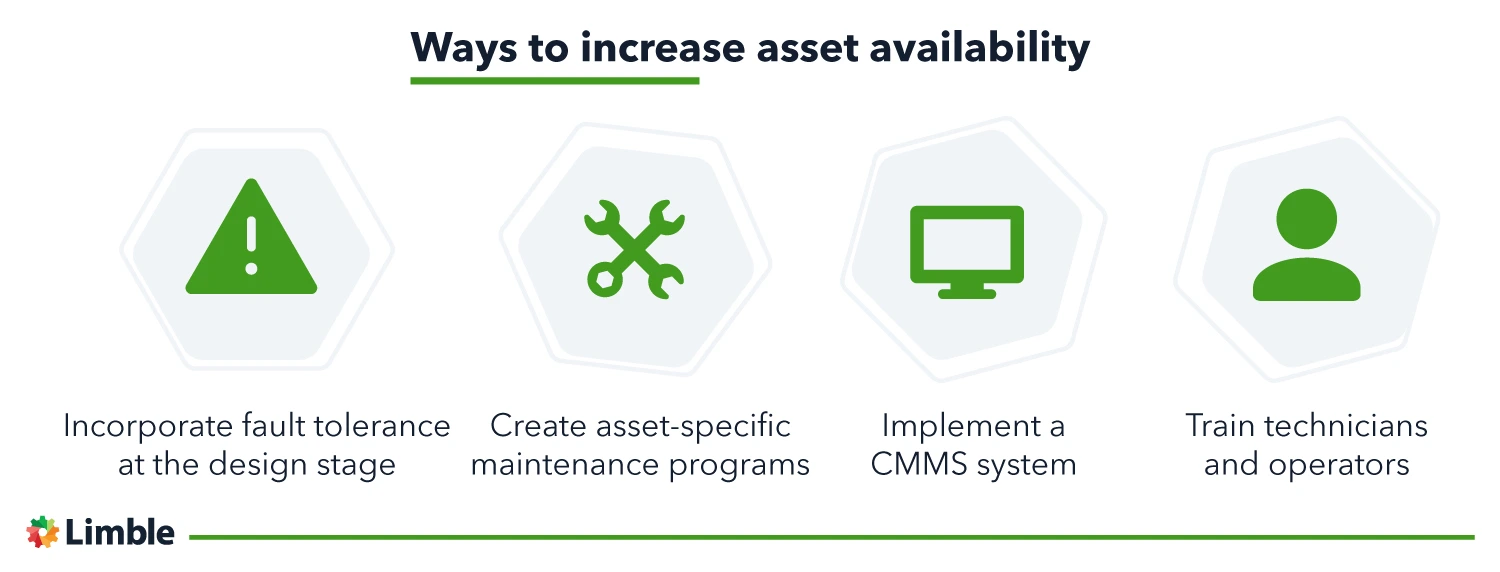The availability parameter can have a big effect on asset utilization and how much value an asset can contribute toward business success.
The purpose of this article is to provide an overview of asset availability and its high-level calculation together with a few very important techniques for improving the availability of critical assets.
The meaning behind asset availability
Asset availability (sometimes called equipment availability) is a metric used to understand if the machine or system is operating satisfactorily at any given time. It is used for repairable and continuously operating equipment in an effort to reduce downtime and optimize on-time performance.
Various asset stakeholders – from design engineers to equipment operators and maintainers – have a stake in improving the availability of the equipment they are responsible for.
The term availability is often interpreted together with two other, interconnected parameters: reliability and maintainability. You need to understand the trade-off relationship between the two to achieve the appropriate level of availability requirements. It is an essential part of Reliability, Availability, and Maintainability (RAM) analysis.
Checklist for Creating a Preventive Maintenance Plan
Following a consistent Preventive Maintenance Plan can make life easier. Use this checklist to create your own!

How to calculate equipment availability?
Mathematically speaking, availability represents the probability of a machine operating without downtime due to a failure or ensuing repair. The industry classifies availability differently for different audiences, based on the type of downtime under consideration and the nature of the audience.
For example, a design engineer may be concerned with availability at the design and product development stage – as opposed to maintenance personnel who may be more interested in how to keep assets healthy to improve their availability. Similarly, the end customer may have its own perception of availability.
For the sake of simplicity, two common classifications include:
- Inherent Availability
- Achieved Availability
Calculating inherent asset availability
Inherent availability is often used by machine designers and original equipment manufacturers (OEM) to report availability performance as part of their machine design. It is represented by the equation below:
The MTTR metric in the equation above only takes into account corrective downtime. It does not include other downtimes associated with preventive maintenance and logistics or administrative-related delays. One of the purposes of this metric is to understand the effects of downtime that have to be addressed during the design stage of the machine.
The corrective downtime – and in turn its inherent availability – can normally be improved at the design stage by enhancing fault tolerance, machine ergonomics and/or simplifying corrective maintenance. In translation, the easier the asset is to repair, the faster it can go back to work.
Imagine you have a machine where two components that are most likely to fail are positioned in a place that’s hard to reach. Design engineers could implement an additional panel at the bottom of the machine. Now, a technician can quickly access and replace those parts without having to partially disassemble the machine.
Over time, this can have a significant impact on asset availability.
Calculating achieved availability
Achieved availability is quite similar to inherent availability, with the difference being the inclusion of downtime due to preventive maintenance along with other delays associated with logistics and administration.
It is represented by the equation below:
This version of equipment availability is more useful to maintenance teams, as the numbers can now also be improved by optimizing preventive maintenance schedules and maintenance actions.
Though the formulas for availability look simple, in practice, the actions and measures we take to improve reliability or maintainability come into conflict with each other – and may not result in increased availability.
How to increase asset availability?
Below are some tips that can be adopted to increase the availability of the asset at different stages of its life cycle (i.e. from the design phase to the operational phase).
1) Incorporate fault tolerance at the design stage
The inherent availability can be increased by improving the design of the machine so that it has greater resilience toward failure. This would increase the reliability of the machine by increasing the MTBF value and would contribute to better availability.
There are different ways to achieve fault tolerance. The most popular way is by incorporating redundancy.
2) Create asset-specific maintenance programs
Improving maintenance programs over time is another effective way to improve overall asset availability.
Machines are often provided with a preventive maintenance schedule by their OEMs. However, such programs are not designed to provide an adequate level of maintenance for the machine through its entire life cycle. As a result, depending upon the operating circumstances where the machine is installed, there is a possibility of over-maintenance and under-maintenance.
Over-maintenance could cause unintended scheduled downtime and reduce availability. Similarly, under-maintenance could cause a premature failure of the machine, leading to unexpected downtime.
The best approach to maximizing asset availability is to tailor the maintenance program to each asset and improve it regularly, based on the health and performance of the machine.
If possible, we recommend running an RCM analysis so you can choose the best maintenance strategy for each asset or failure mode.
3) Implement a CMMS system
Implementing a CMMS is one of the most effective ways to improve asset availability.
CMMS automates the maintenance workflows that improve the efficiency of repair work and reduce machine downtime. It helps reduce human errors and enhances maintenance staff knowledge due to the presence of a strong data foundation on asset failure and performance history.
One simple example is speeding up your troubleshooting processes because CMMS aggregates and offers quick access to SOPs, checklists, and complete maintenance history even while out in the field.
All these factors contribute to the expedited recovery of the asset from its downtime, and improve the overall availability of the machine and the plant.
4) Train technicians and operators
Another proven approach is to enhance the technical competency of the operators and the maintenance staff through scheduled training and information sessions.
You can do this by:
- Having a structured onboarding process for technicians and machine operators.
- Building a strong maintenance training program.
- Creating PM checklists and standard operating procedures for operating and maintaining critical assets.
- Improving the safety culture through regular toolbox talks.
Periodic training would refresh the knowledge base of all plant workers regarding the machines and their operating environment, leading to better employee performance, as well as fewer human errors and safety near-misses.
All of that contributes to shortened planned downtimes and fewer unscheduled downtimes – thus improving equipment availability.
Important takeaways
Availability is a well-known term that has long been used by design engineers as well as maintenance planners and operators. It is often analyzed in conjunction with reliability and maintainability – as all three factors jointly define equipment performance.
For larger and more complex machines, maximizing equipment availability can be a pretty complex exercise that requires support from a CMMS software: it helps you optimize maintenance schedules and resources, and speeds up the execution of maintenance work.
If you are in the market for one, we invite you to give Limble CMMS a try. You can do that by starting a free trial or requesting a personalized walkthrough, no strings attached.


